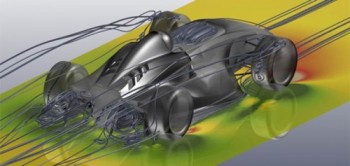
Simulating Car Crashes with Supercomputers – and Lego
October 18, 2019
It’s an experiment many of us have carried out at home: crashing two Lego creations into each other, bricks flying everywhere. But for the researchers at the Read more…

MareNostrum Supercomputer Boosts SEAT’s Vehicle Aerodynamics
June 10, 2019
Spain’s MareNostrum 4, housed at the Barcelona Supercomputing Center (BSC), is helping to design the aerodynamics of every new car that Spanish automobile man Read more…

ISC18’s Industrial Day Slate: Digital Twins, CFD for Automotive, HPC for SMEs
June 23, 2018
For enterprise IT strategists, this year’s Industrial Day (Tuesday, June 26) at ISC18 in Frankfurt will cover a range of topics – digital twins, AI and mac Read more…

NVIDIA Pascal GPUs Coming to Automotive ‘Supercomputer’
January 6, 2016
It's no secret that NVIDIA is eager to take elements of its successful GPGPU ecosystem developed in partnership with the HPC community and transfer these to Read more…

The Evolution of HPC in Manufacturing
July 22, 2014
HPC has reached a tipping point where industry use has expanded dramatically. So what role do supercomputers have in manufacturing? Speaking on this topic is Gr Read more…

Safety Simulation Sets Speed Record
May 8, 2014
For the automotive and aerospace industries, crash and safety analysis by finite elements is used to shorten the design cycle and reduce costs. Recently, a popu Read more…

The Power of Commercial Support for Open Core Products: Tata Steel Automotive Engineering
August 22, 2011
Like most business savvy customers, Tata Steel Automotive Engineering continuously monitors operational costs in an effort to guarantee they are receiving quality solutions, at cost-effective prices. When Tata Steel originally sought a workload management solution, Grid Engine was the perfect fit as an open-source solution. However, self-support solutions often contain hidden costs and risks, which lead TSAE to evolve from an open source solution to a commercial product with commercial support and an open source core, from Univa Corporation. Read more…

High-performance Computing Revs up Simulations like FEA, CFD
December 10, 2009
Automotive and aerospace simulations get a boost from Windows HPC clusters. Read more…

- Click Here for More Headlines

Whitepaper
Transforming Industrial and Automotive Manufacturing
In this era, expansion in digital infrastructure capacity is inevitable. Parallel to this, climate change consciousness is also rising, making sustainability a mandatory part of the organization’s functioning. As computing workloads such as AI and HPC continue to surge, so does the energy consumption, posing environmental woes. IT departments within organizations have a crucial role in combating this challenge. They can significantly drive sustainable practices by influencing newer technologies and process adoption that aid in mitigating the effects of climate change.
While buying more sustainable IT solutions is an option, partnering with IT solutions providers, such and Lenovo and Intel, who are committed to sustainability and aiding customers in executing sustainability strategies is likely to be more impactful.
Learn how Lenovo and Intel, through their partnership, are strongly positioned to address this need with their innovations driving energy efficiency and environmental stewardship.
Download Now
Sponsored by Lenovo
Whitepaper
How Direct Liquid Cooling Improves Data Center Energy Efficiency
Data centers are experiencing increasing power consumption, space constraints and cooling demands due to the unprecedented computing power required by today’s chips and servers. HVAC cooling systems consume approximately 40% of a data center’s electricity. These systems traditionally use air conditioning, air handling and fans to cool the data center facility and IT equipment, ultimately resulting in high energy consumption and high carbon emissions. Data centers are moving to direct liquid cooled (DLC) systems to improve cooling efficiency thus lowering their PUE, operating expenses (OPEX) and carbon footprint.
This paper describes how CoolIT Systems (CoolIT) meets the need for improved energy efficiency in data centers and includes case studies that show how CoolIT’s DLC solutions improve energy efficiency, increase rack density, lower OPEX, and enable sustainability programs. CoolIT is the global market and innovation leader in scalable DLC solutions for the world’s most demanding computing environments. CoolIT’s end-to-end solutions meet the rising demand in cooling and the rising demand for energy efficiency.
Download Now
Sponsored by CoolIT
Advanced Scale Career Development & Workforce Enhancement Center
Featured Advanced Scale Jobs:
HPCwire Resource Library
HPCwire Product Showcase
© 2024 HPCwire. All Rights Reserved. A Tabor Communications Publication
HPCwire is a registered trademark of Tabor Communications, Inc. Use of this site is governed by our Terms of Use and Privacy Policy.
Reproduction in whole or in part in any form or medium without express written permission of Tabor Communications, Inc. is prohibited.
























